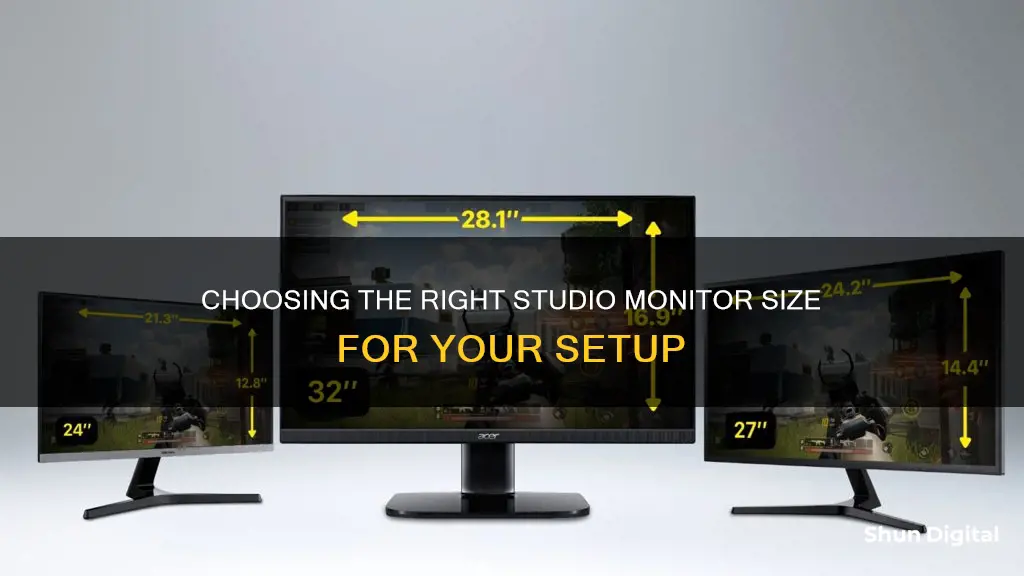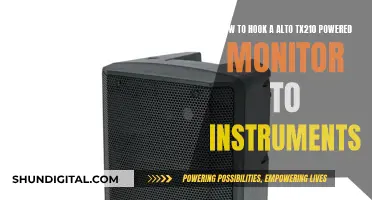
Studio monitors are a crucial piece of equipment for anyone involved in music production. When it comes to choosing the right size, there are several factors to consider, including room size, low-end frequency reproduction, and budget.
The size of a studio monitor typically refers to the woofer diameter, with common sizes ranging from 5 to 8 inches. The larger the woofer, the more low-end frequency it can reproduce. For example, a monitor with an 8-inch woofer can reproduce bass frequencies around 38Hz, while a 5-inch woofer may only reach around 54Hz. If your work involves music with significant low-end frequencies, a larger studio monitor is recommended. However, it's important to consider the size of your room, as larger monitors require more space and can cause issues in smaller, untreated rooms due to phasing and comb filtering.
Another factor to keep in mind is the listening distance. Larger monitors can be placed farther from the listener and tend to have a wider sweet spot range. They are also louder and more suitable if you have a large mixing console or studio desk setup.
For small, untreated rooms, monitors below 5 inches are recommended. These monitors are less powerful and won't activate room modes that can negatively impact the sound quality. Additionally, they are more affordable and portable.
When deciding on the size of your studio monitor, it's essential to consider your specific needs, room size, and budget constraints to make an informed decision.
What You'll Learn

Studio monitor size is based on the woofer
The size of a studio monitor is based on the woofer it uses. The woofer is the driver that produces low-frequency sounds, and the size of the woofer determines the overall size of the monitor. Studio monitors with larger woofers will have larger cabinets, which will take up more space in a room.
When choosing the size of a studio monitor, it is important to consider the size of the room where they will be used. If the room is small, such as a typical bedroom or home studio, smaller monitors with woofers ranging from 3 to 5 inches are more suitable. These smaller monitors provide a compact option that won't take up too much space. However, they may not be ideal for producing heavy bass sounds.
For larger rooms, studio monitors with 6 to 8-inch woofers are recommended. These monitors offer improved bass accuracy and sound quality. They are commonly used in professional recording studios and can handle a wider range of frequencies. However, larger monitors can be heavier and less portable.
The placement of the studio monitors is also crucial. They should be positioned at ear level, creating an equilateral triangle with the listener's position. This ensures optimal sound quality and accuracy. Additionally, the size of the room should be considered when determining the ideal listening distance.
It is worth noting that the power and configuration of the studio monitors also play a significant role in the overall sound quality. Higher wattage can provide clearer transient details, and configurations like bi-amp and tri-amp offer more accurate frequency responses.
Monitors with 17-inch Displays: Are They All Uniform in Size?
You may want to see also

Small studio monitors are best for small rooms
Small studio monitors are ideal for small rooms and home studios as they produce a smaller bass that won't annoy your neighbours. They are also compact, portable, and usually more affordable. However, their small bass may be a disadvantage for those working with bass, mixing, or producing.
When choosing studio monitors, it's essential to consider the size of your room. If you have a regular room at home, a pair of 5-inch monitors should suffice. For bigger rooms, consider 6 to 8-inch monitors. The bigger the monitor, the larger the room should be to ensure proper operation and avoid issues like room mode activation and frequency shift.
If you have a small room that is acoustically untreated, it's best to opt for smaller monitors below 5 inches. These monitors won't reproduce enough bass and will be safer for untreated rooms. Additionally, consider your listening distance, as bigger monitors can be placed farther from the listener and tend to have a wider sweet spot range.
In summary, small studio monitors are the best choice for small rooms, especially if you're working in a home studio or with limited space. They provide a more modest bass response, are easier to transport, and often come at a lower price point. However, if you require more powerful bass reproduction, you may need to consider larger monitors and ensure your room is adequately treated to handle the lower frequencies.
Monitoring Home Electricity Usage: Data Collection Methods
You may want to see also

Medium studio monitors offer the best of both worlds
Medium studio monitors, which typically have a woofer size of 6 to 7 inches, are known for their impressive bass accuracy and overall sound accuracy. They are versatile and can be used in different working environments, depending on your preferences.
If you are working in a regular room at home, a pair of 5-inch monitors should be sufficient. However, if you are working in a bigger room, you may want to consider 6 to 8-inch studio monitors. Medium-sized monitors are ideal for this scenario as they can deliver powerful sound without taking up too much space.
The Yamaha HS5 studio monitors are a popular choice for this very reason. They offer precise stereo imaging, accurate mids and highs, and a well-defined bottom end, making them a versatile option for both beginners and professionals.
Another great option is the Kali Audio LP-6 studio monitors, which provide excellent value for money. They have a smooth and detailed response, a wide sweet spot, and flexible tuning options to adapt to your specific setup.
Ultimately, medium studio monitors provide a great balance of size and performance, making them a versatile choice for a range of studio environments.
Dual Monitor Setup: Consistent Image Sizing
You may want to see also

Large studio monitors are ideal for recording studios
Secondly, large studio monitors are often equipped with multiple drivers and amplifiers, providing a more efficient expression of the complete frequency range. This results in a more accurate and dynamic sound, which is crucial for professional-level productions. Additionally, larger monitors can include advanced features such as sophisticated DSP (Digital Signal Processing) to compensate for complex room acoustics, ensuring an optimal listening experience.
Furthermore, large studio monitors are often designed with a wider stereo image, providing a broader sweet spot for critical listening and group listening sessions. This feature is particularly advantageous for collaborative work in recording studios, allowing multiple people to experience the mix accurately.
While large studio monitors may not be as portable or suitable for smaller spaces, they excel in delivering high-quality sound reproduction and are a standard choice for many professionals in the recording industry. Their ability to handle higher power and produce a wider frequency range makes them a preferred option for critical listening and mixing applications in recording studios.
Electricity Monitors: Accurate or Deceitful?
You may want to see also

Studio monitor stands are important, especially in small rooms
The size of a studio monitor is based on the woofer diameter, with common sizes including 8-inch, 5-inch, and smaller. The size of the monitor determines its ability to reproduce low-end frequencies, with larger monitors capable of producing more low-end. When choosing a studio monitor, it is crucial to consider the size of the room as the bigger the monitor, the larger the room should be.
In small rooms, studio monitor stands play a significant role in ensuring optimal sound quality. By elevating the monitors, stands allow the sound to move around freely without being affected by the floor or nearby walls. This is especially important in small rooms where vibrations and reflections can be more pronounced. Additionally, the position of the studio monitors is crucial for accurate sound quality. Placing the monitors in a triangular shape can help achieve the ideal sound quality in a small room.
For small rooms, it is generally recommended to choose studio monitors below 5 inches in size. These smaller monitors are suitable for untreated rooms as they won't activate room modes or cause issues like phase cancellation. They are also more affordable and have a compact design, making them ideal for home studios or smaller spaces. However, one disadvantage of smaller monitors is their limited bass response, which may be inadequate for those working with bass-heavy music.
While larger studio monitors offer improved low-end frequency reproduction, they require a larger room to function properly. If placed in a small room, larger monitors can easily activate room modes, resulting in phase cancellation and sound build-up issues. Therefore, for small rooms, it is crucial to prioritize monitor stands and proper positioning over monitor size to achieve the best sound quality.
Removing the ASUS ROG Swift Monitor Stand: A Step-by-Step Guide
You may want to see also
Frequently asked questions
The size of your studio monitor depends on the size of your room and the type of music you are working with. If you have a small room, a studio monitor with a woofer size of 5 inches or below is recommended. If you have a bigger room, you can opt for a studio monitor with an 8-inch woofer. Additionally, if you are working with music that has more low-end frequency information, a bigger studio monitor will be more suitable.
Small studio monitors typically range from 3 to 5 inches and are ideal for small rooms or home studios as they produce a smaller bass that won't disturb your neighbours. Medium studio monitors range from 6 to 7 inches and offer impressive bass accuracy and sound accuracy. Large studio monitors are usually 8 to 10 inches and are commonly used in recording studios.
In addition to room size and low-end frequency reproduction, you should also consider the room treatment, listening distance, and your budget. If you have an untreated room, it is recommended to start with a studio monitor below 5 inches. If you have a treated room, you can opt for a larger size, especially if you need to monitor low-end frequencies.







